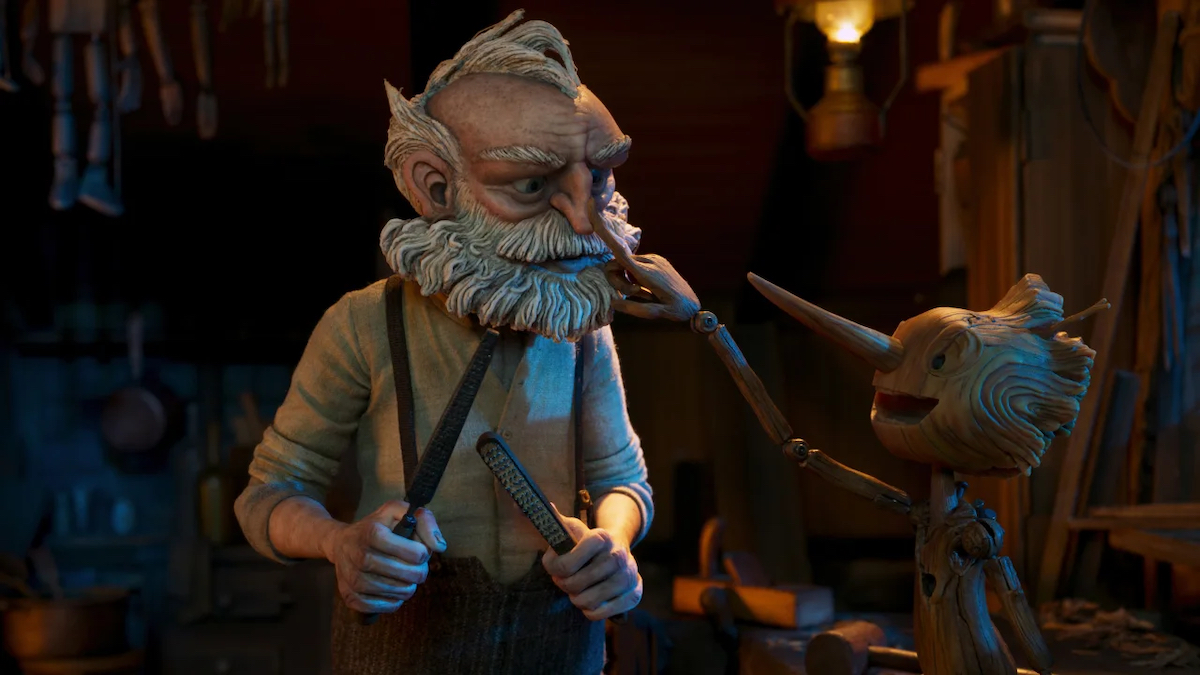Guillermo del Toro’s career is evidence that the Oscars still favor the romance of the left. He has just won the Best Animated Feature award for his Pinocchio, which he set in Fascist Italy. If liberal opinion can treat political opposition as fascism, why shouldn’t del Toro do likewise? His previous success was The Shape of Water (2017), which won him Best Picture and Best Director awards for portraying ’50s America as fascist. His Oscar nominations are similar: Nightmare Alley (2021) hints at America as fascist and Pan’s Labyrinth (2006) was set in Franco’s Spain.
This prestige persuaded Netflix to pay for this new Pinocchio and its impressive cast. Ewan McGregor plays Walt Disney’s Jiminy Cricket, Tilda Swinton the Blue Fairy, Christoph Waltz and Cate Blanchett are the villainous fox and monkey that tempt Pinocchio with theatrical glory, and Ron Perlman is a fascist villain (del Toro’s conceit), with John Turturro and Tim Blake Nelson in other small roles. They are voice actors here: Guillermo del Toro’s Pinocchio is stop-motion animation, and it’s better animation than anything available. It makes Disney, including its own new Pinocchio, look amateurish.
If all this suggests a movie made for adults rather than children, that is because our society is continuously blurring the difference between children and adults, including by rewriting stories. So del Toro’s Jiminy Cricket is a fan of Schopenhauer, so his comical moments depend on his decrying life as suffering. The Blue Fairy is now a spirit of the woods; her sister, Death, shaped like a chimera, explains to Pinocchio that the meaning of life comes from its brevity.
Why tell children’s stories then? Because childish moralism is the most popular, possibly the only really popular, part of left-wing politics. It sells a revolutionary individualism whose evidence comes from hysteria at being rejected or denied. Behold: The story begins in a small Italian town in 1916, in a conservative paradise. Geppetto prays with his son and his major work is the carved Christ statue for the local church. He’s called a model Italian citizen.
But then he loses his son to bombing during the Great War and later, when he makes Pinocchio, the people in church call Pinocchio the devil’s work and reject him, while the Fascists call him a dissident and independent thinker; “belief” and “obedience” are presented as Fascist slogans. The community is now presented as witch hunters. Authority is damned as authoritarianism, and the story becomes an indictment of fathers’ demands of their sons, as wrongful counsels of fear or trauma.
Instead of being tempted on Pleasure Island, the boys in this version of the story are tempted by competition—they are trained to become child soldiers in a Fascist fortress. But as should be obvious by now, children are pure, their desires are above reproach, and they easily prefer friendship and fun to anything harsh. They prove incapable of cruelty and courageous enough to risk death to save each other. This liberation of the youth seems to be the epitome of left-wing political psychology—only on the basis of this fairy tale purity can the young be encouraged to practice every violence against the society that failed to educate them.
This is why it’s necessary to have Pinocchio mock Mussolini. What is more childish than such a fantasy of speaking truth to power that puts pacifist sacrifice at the moral core of life only to suggest that sacrifice is fake, you can eat your cake and have it, too, come the happy end! But behind the politics lies the source of art—religion: Pinocchio asks Geppetto why people sing to the carved Christ and yet don’t like him, Pinocchio, a carved puppet, another of Geppetto’s creations. Then the Blue Fairy tells Geppetto that Pinocchio became a real boy to save him. Indeed, Pinocchio is also crucified by the vulpine villain. Apparently, left-wing politics needs Christianity’s salvific story as a puppet, but must also destroy religion by caricaturing the faithful and the priest both.
I dislike the left-wing politics, but the movie is as clever as its animation, far outstripping the films that usually win Oscars. Pinocchio is a metaphor for works of art “taking on a life of their own,” which is an obvious enough interpretation but not usually taken seriously. Del Toro’s script has Pinocchio become immortal. He keeps coming back to life when he dies, although he faces temporary oblivion; every time he dies, he spends more time suspended in a kind of limbo, which extends the metaphor—stories are forgotten and recovered or reinterpreted, they get a new life, but they can face political destruction for being too provocative.
As the audience expects, Pinocchio chooses mortality instead, to live with his loved ones. This is where the metaphor collapses and any claim to art is replaced by a moralistic ideology that wants both the benefits or comforts of peace and the moral stature of pacifism. As a work of art, Pinocchio can be of some benefit or give pleasure but cannot love. As a character in a typical drama involved with other characters, Pinocchio would be annihilated by chance or tyranny given the childish irresponsibility or innocence, which nevertheless charms the audience. The story thus collapses but only for those who think things through.
Everyone else can enjoy the way del Toro mixes two different meanings of creativity by the emphasis on childishness. Giving life and giving meaning are put together in Pinocchio, just like the left-wing moralism and the attack on “patriarchy” are put together as deluded and bound by death. Just like every other adaptation, this one also plays on childhood’s sense of wonder and the way it charms adults. But it goes further than any other in suggesting that nowadays people divinize their children or else the confusions in the story wouldn’t work emotionally. As divinities, the children are able not only to fulfill their parents’ fantasies but also to protect them. This is, of course, a full inversion of the natural order.
I criticized the Disney Pinocchio for its therapeutic ideology; but this ideology of pacifism and creativity deserves even more criticism, precisely because it is more attractive to the Oscars, to audiences and artists as well, more likely to be considered idealistic, pure, well-intentioned. Pinocchio as anti-Fascist hero is an even worse attack on art, including children’s stories. Something else, neither warlike nor pacifist, something moderate, is needed to oppose this madness, and I can’t say I’ve seen any such entertainments recently.

